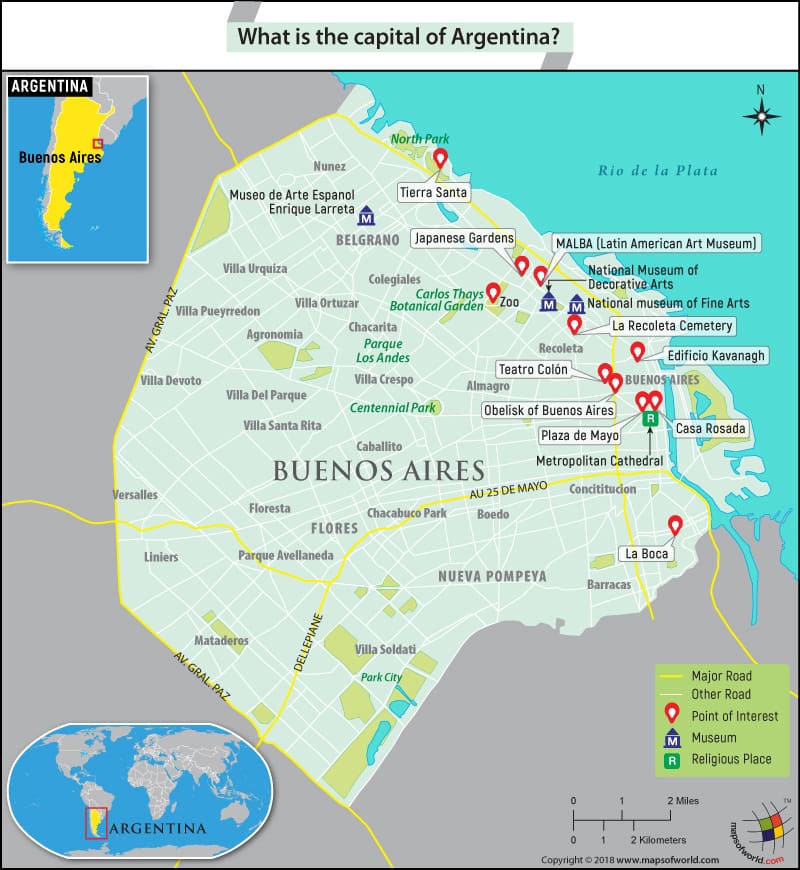What Is the Capital of Argentina?

Argentina is a country in South America. Occupying the southern tip of South America, Argentina is known for its diverse landscapes from Andes mountains to icy glaciers and sunny beaches. In this article, we will learn about what is the capital of Argentina, its former capitals, and much more.
Capital of Argentina
Buenos Aires is the capital city of Argentina. It’s a lively city bursting with history, culture, and excitement. People often call it the “Queen of the Plata“, and it’s filled with beautiful European-style buildings, like fancy theaters and colorful houses. The city is like a mixing pot of different influences, offering amazing museums, passionate tango dances, and delicious food worldwide. Buenos Aires is a place where people love to chat in cozy cafes late into the night, enjoy lively weekend markets with local artists, and embrace a joyful way of living.
Buenos Aires means ‘fair winds’ or ‘good winds’ by that, the intended meaning was ‘good weather’ by the area’s founder. The city of Buenos Aires is believed to have been established by the Spanish in the 16th century and was named Nuestra Senora Santa Maria del Buen Aire( translated into Our Lady St Mary of the Good Air).
Where is Buenos Aires?
Buenos Aires is situated in the southeastern region of South America, specifically on the eastern coast of Argentina. The city lies on the northern bank of the Río de la Plata, one of the world’s widest estuaries, and serves as a natural border between Argentina and Uruguay. The city is located in the northeastern part of the Buenos Aires Province, the largest province in Argentina. Buenos Aires is approximately 240 kilometers inland from the Atlantic Ocean.
The city’s strategic position along the coast has historically made it a hub for international trade and transportation, contributing to its significance as a major cultural, economic, and political center in South America.
Interesting Facts about Buenos Aires
Some of the interesting facts about Buenos Aires are as follows:
- The famous tango dance, which people strongly associate with Argentina, actually started in some unexpected places. It began in the rough neighborhoods of Buenos Aires in the 19th century.
- In Buenos Aires, the Jardín Japonés proudly features the largest Japanese garden outside of Japan itself! Named the Jardín Japonés, it offers visitors a peaceful paradise to take a break from the busy city life and feel calm and relaxed.
- It is home to the widest avenue in the world, called Avenida 9 de Julio. This avenue is incredibly wide, with a staggering 14 lanes of traffic. It is quite a spectacle to witness.
- The Buenos Aires subway system, constructed in 1913, holds the distinction of being the oldest in all of Latin America. Its fascinating history includes the decoration of many stations with beautiful artwork and murals.
- Experts consistently rank the University of Buenos Aires as a prestigious institution among the top universities in Latin America.
- Buenos Aires holds the title for the most bookstores per capita in the world. With over 734 bookstores, the city shows a deep love for reading and how lively its literary scene is.
- Buenos Aires has more than 300 theaters, which puts it among the top theater cities globally. The famous Teatro Colon is especially well-known for its fantastic sound quality and is where you can enjoy opera, ballet, and classical music shows.
Former Capitals of Argentina
Several cities served as capitals before Buenos Aires became the permanent capital of Argentina:
-
Santiago del Estero
It was the capital of Argentina’s first colonial administration in the 16th century.
-
Buenos Aires
Initially founded in 1536, it became the capital of the Viceroyalty of the Río de la Plata in 1776.
-
San Miguel de Tucumán
This city served as the provisional capital during the Argentine War of Independence. The signatories signed the Declaration of Independence there in 1816.
Related Links